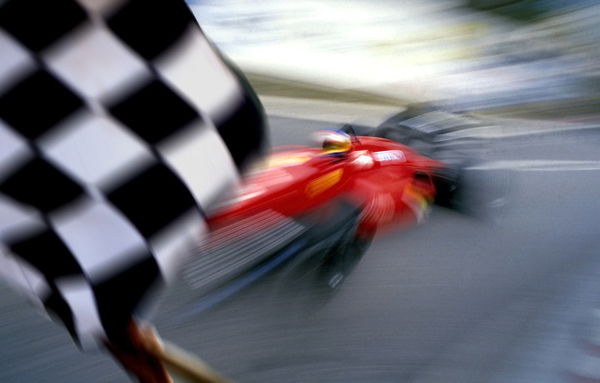

Winning an F1 race requires more than talent and a good car. It requires a certain combination of talent, luck, and car at just the right time. Forgetting record breakers like Schumacher and Vettel, F1 history is full of drivers who had just one day in the sun. So here’s a list of Formula One 1-win wonders who climbed the top spot only once in their career.
Formula One 1-win wonders
JEAN ALESI
ADVERTISEMENT
Article continues below this ad

via Imago
JEAN ALESI
1995 Canadian GP
He burst onto the Formula 1 scene with Tyrrell in 1989 and memorably battled Ayrton Senna for the lead in Phoenix the following season. Jean Alesi looked set to be a multiple-winner, but a move to Ferrari and some appalling luck kept him off the top step of the podium.
That was until the 1995 Canadian Grand Prix and the Frenchman’s 31st birthday. Alesi qualified fifth and moved past Ferrari team-mate Gerhard Berger just as the Williams of David Coulthard spun off in front of them.
With Michael Schumacher’s Benetton streaking away in front, the Ferraris closed on Damon Hill, struggling with his Williams. Alesi made it by at the hairpin on lap 17 and left Berger to battle his way past Hill. After the stops, Schumacher was around half a minute clear and Alesi had settled for yet another second place. Then, with a little over 11 of the 69 laps to go, Schumacher hit gearbox trouble. Alesi swept by and cruised home to finally record his first F1 victory in his 91st GP.
“It felt unbelievable to win; I finished second 16 times,” Alesi recalled years later. “OK, I won, but it was more of a relief than anything. It was a tough weekend, I had to overtake a lot of people to run second to Michael. And then his car stopped and I thought: ‘Finally!’ Then I was worried about the fuel because Gerhard had run out before his pitstop. I ran out on the slowing-down lap!”
More near misses and 16 further podiums followed, but Alesi’s luck would never hold like it did that day in Montreal. This why he is one of Formula One 1-win wonders
JEAN-PIERRE BELTOISE

via Imago
JEAN-PIERRE BELTOISE
1972 Monaco GP
His Monaco success wasn’t just one of the best one-off victories, it was one of the greatest F1 drives of all time. Jean-Pierre Beltoise had arrived in Grand Prix racing in 1967. He won the ’68 European F2 title and had scored six F1 podiums with Matra by the time he arrived in Monte Carlo with BRM.
Beltoise qualified fourth before a torrential rain hit on race day. After an extra practice session to allow drivers to acclimatise to the conditions, the field set off.
Beltoise immediately shot by front-row men Emerson Fittipaldi (Lotus 72) and Jacky Ickx (Ferrari 312B2) to lead up the hill towards Casino. After three laps he was five seconds clear of Clay Regazzoni’s Ferrari and his lead grew further when Regazzoni slid down a slip road and took Fittipaldi with him.
That day Beltoise drove with inspired confidence. Any thoughts that it was a spray less road that enabled him to pull away were quickly dispelled by the way he handled traffic. He passed people on the left, right, and centre and wasn’t above putting a wheel on the pavement if the situation demanded it.
Ickx, an established wet-weather ace who had taken his first championship victory by almost two minutes in the rainy 1968 French GP, took up the chase. But he was powerless to stop Beltoise, who set the fastest lap by over half a second. He eventually came home almost 40 seconds clear, with Fittipaldi a lap behind in third.
Beltoise scored no other points in 1972 and would only record one more podium, but on that day in Monaco he had defeated the best in the world. He may be one of Formula One 1-win wonders but he did it at one of the most iconic F1 venues.
ALESSANDRO NANNINI

via Imago
ALESSANDRO NANNINI
1989 Japanese GP
The 1989 Japanese GP is remembered for the infamous clash between Ayrton Senna and Alain Prost, Senna’s recovery to victory and subsequent exclusion. But it also gave Alessandro Nannini an F1 win before his helicopter crash in ’90.
The Benetton driver qualified sixth and immediately rose to fourth, behind Prost, Senna and the Ferrari of Gerhard Berger. Just after half-distance, Berger hit gearbox trouble and the challenging Nigel Mansell dropped out 10 laps later, leaving Nannini well clear in third.
With such a big gap to the McLarens, he backed off. It was a prudent course to take, but later everyone, Alessandro included, wished he had kept up the pace. It would have prevented a great deal of controversy.
Thus, when the McLarens clashed and Senna toured around to the pits for a new nosecone, Nannini inherited a lead that was not as big as it could have been. Senna charged back and overtook Nannini with just over two laps to go.
But Nannini still got to stand on the top of the Suzuka podium, as Senna was disqualified for not returning to the track where he had left it, and Benetton’s second F1 victory was confirmed. Nannini makes onto our list of Formula One 1-win wonders on mere technicalities but it still counts.
ROBERT KUBICA

via Imago
ROBERT KUBICA
2008 CANADIAN GP
Robert Kubica would surely have racked up more wins and perhaps a title or two beyond his 2008 Canadian Grand Prix victory had it not been for his rally crash at the start of ’11.
The scene of his horrific crash a year before, the Circuit Gilles Villeneuve in Montreal definitely owed something to Robert Kubica in 2008. Perhaps even a watershed moment so fortunate and astonishing had been his dodging of mortality when his Sauber-BMW careered off the track and slammed into a retaining wall with car-disintegrating force.
When the lights went green the Hamilton stormed off the grid and progressively knitted himself a comfortable cushion over Kubica, but then the safety car was deployed so the marshals could tend to the stranded Force India of Adrian Sutil. Most of the front-runners headed for the pits, but as a result of quicker stops, both Kubica and Raikkonen reached the exit of the pitlane before Hamilton and lined up alongside each other as they waited for the red light to go green. Oblivious of the ‘traffic signal’, and with insufficient time to react, Lewis ploughed into the back of the Ferrari, putting both cars out on the spot!
As the lead rotated from one driver to the other, the Pole pulled out all the stops and made a stirring run before his second pit stop to reduce the gap with his team mate, ultimately overtaking the German and leading the BMW duo home for a resounding 1-2 triumph. Kubica is on our list of Formula One 1-win wonders as he was a talented driver and he did it at the same track where he had a massive accident.
ADVERTISEMENT
Article continues below this ad
CARLOS PACE

via Imago
CARLOS PACE
BRAZILIAN GP 1975
In the 1970s the almost ubiquitous Cosworth DFV engine allowed a number of F1 teams to build competitive racers, and three different drivers took their only world championship successes during 1975.
ADVERTISEMENT
Article continues below this ad
The Brabham BT44B was one of the best chassis at the start of the season and allowed rising Brazilian star Carlos Pace a chance to shine. He qualified second in the opening round in Argentina and took his only F1 world championship pole at Kyalami, outpacing team-mate Carlos Reutemann by just 0.07s. In between, he also scored his one race victory, on home turf at Interlagos.
When the dominant Shadow of Jean-Pierre Jarier, which had built up a lead of half a minute, was struck by fuel-metering problems, Pace moved to the front. Emerson Fittipaldi’s McLaren kept the pressure on, but Pace kept him at arm’s length and took a popular win by six seconds.
ADVERTISEMENT
ADVERTISEMENT
ADVERTISEMENT
ADVERTISEMENT

